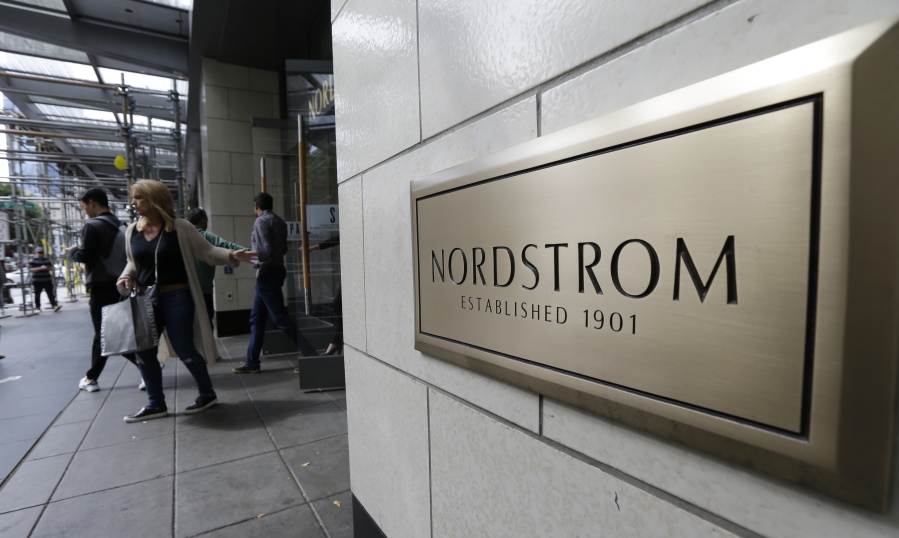Even as many retailers have enjoyed booming sales, Nordstrom watched its share price plunge Tuesday as inventory issues, rising labor costs and missed opportunities led to third-quarter results well below market expectations.
The Seattle-based retailer reported a profit of $64 million for the quarter ending Oct. 30, a 21% improvement over the same quarter in 2020 but barely half of what the company earned in the third quarter in 2019, before the pandemic.
Net sales also disappointed: The $3.5 billion posted for the quarter was about 18% higher than the same quarter a year ago, but 1% below that quarter in 2019.
In a call Tuesday afternoon with analysts, Nordstrom executives pointed to external challenges, such as supply-chain problems and lagging sales in urban markets, where the effects of the pandemic on in-store shopping are more pronounced.
But they also acknowledged that Nordstrom, Seattle’s last big hometown retailer in the era of Amazon, was slow to make course corrections as problems arose.
“We have not responded as quickly and as aggressively as we need to,” Pete Nordstrom, Nordstrom’s president and chief brand officer, told analysts.
Tuesday’s results, which follow lower-than-2019 earnings in the second quarter and a $166 million loss in the first quarter, also came in well below analyst expectations for the third quarter. The company’s share prices fell nearly 25% Tuesday in after-hours trading, to $24.53, after closing Tuesday at $31.93. That appeared to the lowest price since last November, though it was still roughly twice the levels seen in the first months of the pandemic.
“The market is currently extremely volatile, punishing retailers more than normal who are not meeting or exceeding expectations and rewarding those who are,” said Zachary Warring, equity analyst at CFRA Research in New York.
Nordstrom’s third-quarter struggles come as the retailer tries to navigate a global pandemic while repositioning itself to compete in the age of digital shopping.
Sales at the retailer’s Rack discount stores were 8% below 2019 levels, in contrast to its name-brand department stores, which were up a modest 3% for the same period.
The Rack’s struggles partly reflected inventory shortages, particularly in core categories such as women’s apparel and shoes, where demand was higher than the retailer had expected, Pete Nordstrom said.
“Our source of goods got disrupted in the pandemic and it resulted in … just a flat out shortage of inventory,” he said. “We responded by trying to increase supply as quickly as possible, but weren’t able to land as much product as we needed in certain core categories and missed an opportunity to capture incremental sales as a result.”
Another miss, the retailer said, was in overstocking the Rack with lower-priced items in a bid to keep bargain-hunters from jumping to discount competitors. “Frankly, we went too far,” Pete Nordstrom said. “We brought some more products in categories that we’ve heard from customers that is not what they’re looking for.”
Neil Saunders, a retail analyst and managing director at GlobalData Retail, put it in stronger terms. “Most shops are a complete mess and have too much stock, which makes it hard to shop,” he said in an email Tuesday afternoon.
There was good news, though. Nordstrom reported improvement in categories such as formal and office wear and makeup — “a promising signal that customers are beginning to return to social and work events,” the company said.
Nordstrom’s heavy investments in digital retail continued to pay off. Online sales for the quarter, though down 12% versus 2020, when online sales were surging for many retailers, were up 20% compared to 2019, and today account for 40% of sales.
Another bright spot is Nordstrom’s efforts to blend online and in-person shopping — for example, with in-store pickup of online orders, which currently “provides our highest satisfaction customer experience” and is “our most profitable customer journey,” CEO Erik Nordstrom said.
Officials said the company was undertaking a “comprehensive look” at ways to improve performance at its Rack stores and in its supply chain and “inventory flow” and was confident of a “much improved position for the holiday season.”
Still, investors appeared to need more persuasion. Nordstrom’s third-quarter earnings undershot analysts’ forecasts by around 30%, and CFRA’s Warring notes that expected earnings for the year, though up 35% versus 2020, will still be 7% below 2019.
Saunders, with GlobalData Retail, lauded Nordstrom’s frankness about its problems, but thinks the retailer faces a tough road ahead in making the necessary changes.
“Management have recognized the issues and say they are trying to resolve them,” Saunders said. “But the problems have been inherent in the business for over a year now so there is a degree of skepticism over whether they can deliver.
Those questions are all the more pointed given that other retailers are enjoying record sales fueled by pent-up consumer demand. Both Macy’s and Kohl’s, often seen as rivals to Nordstrom, recently raised their forecasts for 2021.
“Consumers are out spending in force,” Saunders said. “Nordstrom is missing out on the retail party.”



